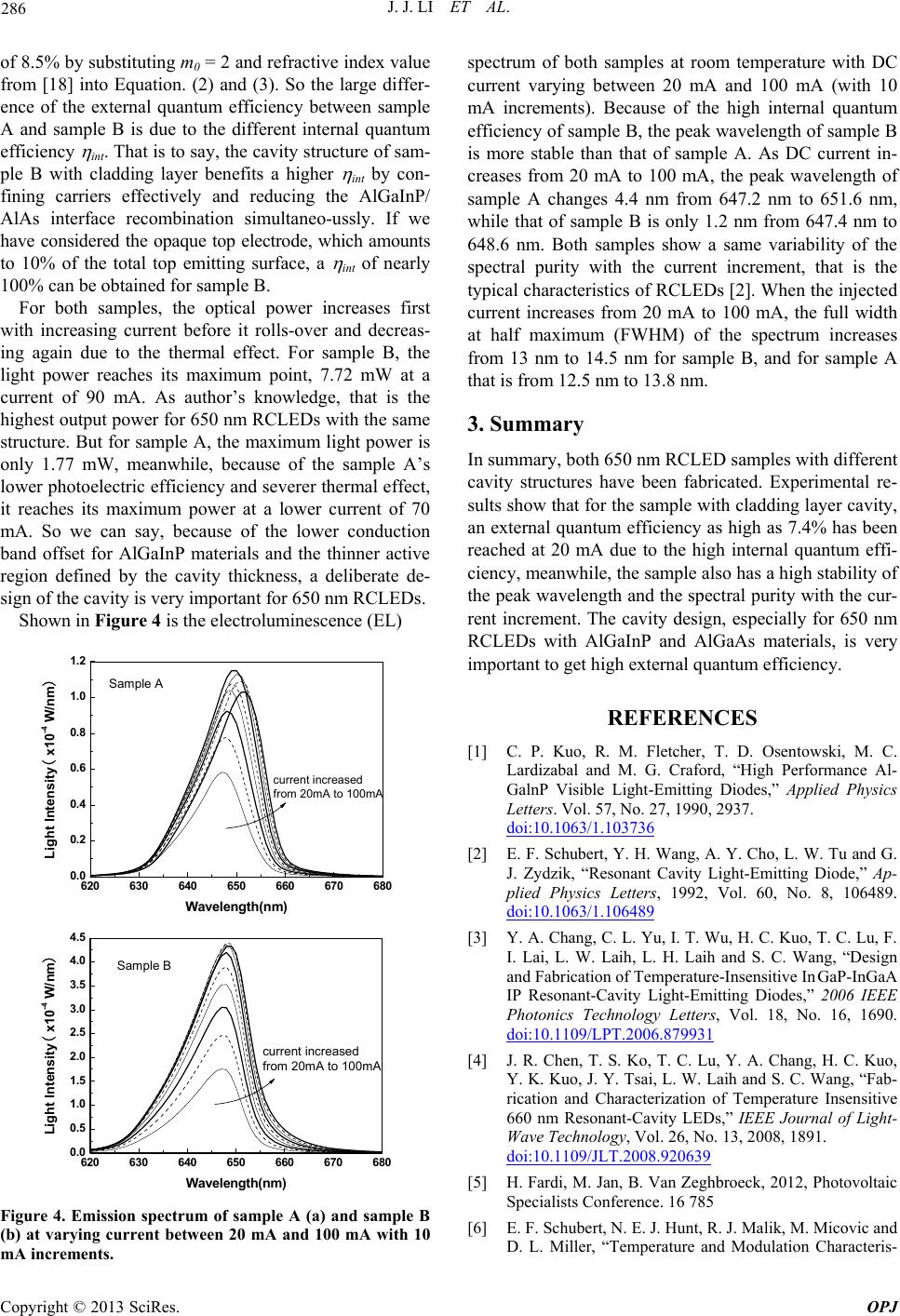
J. J. LI ET AL.
286
of 8.5% by substituting m0 = 2 and refractive index value
from [18] into Equation. (2) and (3). So the large differ-
ence of the external quantum efficiency between sample
A and sample B is due to the different internal quantum
efficiency
int. That is to say, the cavity structure of sam-
ple B with cladding layer benefits a higher
int by con-
fining carriers effectively and reducing the AlGaInP/
AlAs interface recombination simultaneo-ussly. If we
have considered the opaque top electrode, which amounts
to 10% of the total top emitting surface, a
int of nearly
100% can be obtained for sample B.
For both samples, the optical power increases first
with increasing current before it rolls-over and decreas-
ing again due to the thermal effect. For sample B, the
light power reaches its maximum point, 7.72 mW at a
current of 90 mA. As author’s knowledge, that is the
highest output power for 650 nm RCLEDs with the same
structure. But for sample A, the maximum light power is
only 1.77 mW, meanwhile, because of the sample A’s
lower photoelectric efficiency and severer thermal effect,
it reaches its maximum power at a lower current of 70
mA. So we can say, because of the lower conduction
band offset for AlGaInP materials and the thinner active
region defined by the cavity thickness, a deliberate de-
sign of the cavity is very important for 650 nm RCLEDs.
Shown in Figure 4 is the electroluminescence (EL)
620 630 640650 660 670 680
0.0
0.2
0.4
0.6
0.8
1.0
1.2
Sample A
Light Intensity( x10-4 W/nm)
Wavelength(nm)
current increased
from 20mA to 100mA
620 630 640 650 660 670 680
0.0
0.5
1.0
1.5
2.0
2.5
3.0
3.5
4.0
4.5
Light Intensity( x10-4 W/nm)
Wavelength(nm)
Sample B
current increased
from 20mA to 100mA
Figure 4. Emission spectrum of sample A (a) and sample B
(b) at varying current between 20 mA and 100 mA with 10
mA increments.
spectrum of both samples at room temperature with DC
current varying between 20 mA and 100 mA (with 10
mA increments). Because of the high internal quantum
efficiency of sample B, the peak wavelength of sample B
is more stable than that of sample A. As DC current in-
creases from 20 mA to 100 mA, the peak wavelength of
sample A changes 4.4 nm from 647.2 nm to 651.6 nm,
while that of sample B is only 1.2 nm from 647.4 nm to
648.6 nm. Both samples show a same variability of the
spectral purity with the current increment, that is the
typical characteristics of RCLEDs [2]. When the injected
current increases from 20 mA to 100 mA, the full width
at half maximum (FWHM) of the spectrum increases
from 13 nm to 14.5 nm for sample B, and for sample A
that is from 12.5 nm to 13.8 nm.
3. Summary
In summary, both 650 nm RCLED samples with different
cavity structures have been fabricated. Experimental re-
sults show that for the sample with cladding layer cavity,
an external quantum efficiency as high as 7.4% has been
reached at 20 mA due to the high internal quantum effi-
ciency, meanwhile, the sample also has a high stability of
the peak wavelength and the spectral purity with the cur-
rent increment. The cavity design, especially for 650 nm
RCLEDs with AlGaInP and AlGaAs materials, is very
important to get high external quantum efficiency.
REFERENCES
[1] C. P. Kuo, R. M. Fletcher, T. D. Osentowski, M. C.
Lardizabal and M. G. Craford, “High Performance Al-
GalnP Visible Light-Emitting Diodes,” Applied Physics
Letters. Vol. 57, No. 27, 1990, 2937.
doi:10.1063/1.103736
[2] E. F. Schubert, Y. H. Wang, A. Y. Cho, L. W. Tu and G.
J. Zydzik, “Resonant Cavity Light-Emitting Diode,” Ap-
plied Physics Letters, 1992, Vol. 60, No. 8, 106489.
doi:10.1063/1.106489
[3] Y. A. Chang, C. L. Yu, I. T. Wu, H. C. Kuo, T. C. Lu, F.
I. Lai, L. W. Laih, L. H. Laih and S. C. Wang, “Design
and Fabrication of Temperature-Insensitive InGaP-InGaA
IP Resonant-Cavity Light-Emitting Diodes,” 2006 IEEE
Photonics Technology Letters, Vol. 18, No. 16, 1690.
doi:10.1109/LPT.2006.879931
[4] J. R. Chen, T. S. Ko, T. C. Lu, Y. A. Chang, H. C. Kuo,
Y. K. Kuo, J. Y. Tsai, L. W. Laih and S. C. Wang, “Fab-
rication and Characterization of Temperature Insensitive
660 nm Resonant-Cavity LEDs,” IEEE Journal of Light-
Wave Technology, Vol. 26, No. 13, 2008, 1891.
doi:10.1109/JLT.2008.920639
[5] H. Fardi, M. Jan, B. Van Zeghbroeck, 2012, Photovoltaic
Specialists Conference. 16 785
[6] E. F. Schubert, N. E. J. Hunt, R. J. Malik, M. Micovic and
D. L. Miller, “Temperature and Modulation Characteris-
Copyright © 2013 SciRes. OPJ